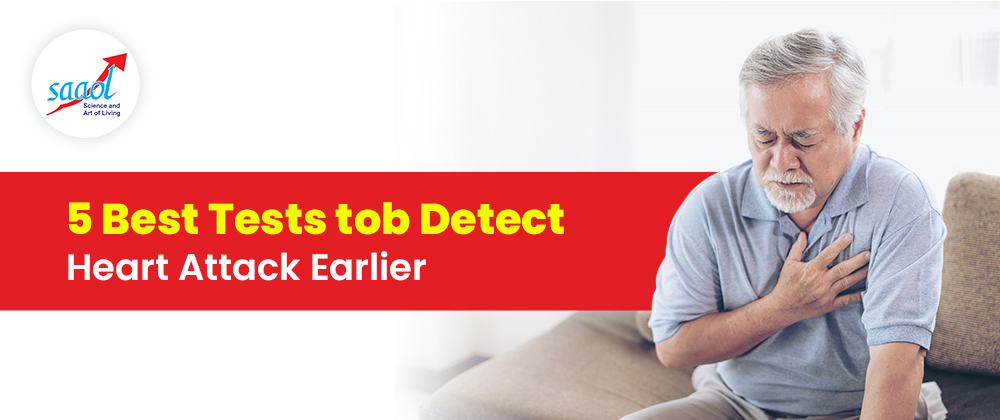5 Best Tests to Detect Heart Attacks Earlier
SAAOL
- January 17, 2023
- 6 Min Read

If you can detect heart attack through some simple tests and knowing the early warning signs of a heart attack can prove to be a blessing for you. In this blog, we are going to learn about the tests you must go through and the warning signs of a heart attack that you must know, to save your life.
Let’s discuss some general tests and the most important test, CT Angiography or CT Scan, which will help you detect heart attack earlier and the warning signs of a heart attack.
1. Electrocardiogram
An electrocardiogram (ECG or EKG) is a test that measures the electrical activity of the heart. It generates a graph of the heart’s activity and rhythm that a medical specialist may read to determine the heart’s health. The test is normally non-invasive and painless. It is used to identify several heart diseases, such as heart attacks, arrhythmias (irregular heartbeats), and damage to the heart from inadequate blood supply.
Note: ECG is not always successful in detecting heart disease early, therefore, you can go for other tests like Echocardiogram, TMT, or CT Scan.
2. Echocardiogram
An echocardiogram is a test that employs sound waves to produce fine-grained images of the heart. It is sometimes referred to as a cardiac ultrasound or simply as an “echo.” It can be used to determine how effectively the heart is working overall as well as to identify particular cardiac issues such as heart valve issues, heart defects, and heart disease warning symptoms.
It can detect heart disease earlier because it provides detailed information about the spread of heart disease, its function, and its structure.
3. Treadmill test (TMT) or Stress Test
A treadmill test, also known as an exercise stress test, is a diagnostic procedure for assessing cardiovascular health and identifying any underlying heart problem. A treadmill is used for the test, and the subject is connected to an electrocardiogram (ECG) equipment to record their heart’s electrical activity as they move around on the machine. The pace and inclination of the treadmill are gradually raised to replicate the effects of exercise and stress on the heart.
This test is non-invasive and usually comfortable. Patients who have chest pain, shortness of breath, exhaustion, or fainting symptoms typically undergo this test. It will help you to show early warning signs of a heart attack.
4. Angiogram
Angiography is a diagnostic procedure that uses X-ray imaging to see inside the heart and blood arteries. It is an invasive procedure used to find and identify heart diseases such as coronary artery disease, which is a narrowing or obstruction of the arteries that feed blood to the heart.
Although this method is the standard method for diagnosing heart disease, there are various risks involved. Before an angiogram, it may sometimes be necessary to do a non-invasive test to look for any heart disease or early warning signs of a heart attack, such as a stress test or a CT angiography.
5. CT Angiography
Also known as CT Scan, it is a non-invasive and one of the most important and effective ways to detect heart disease earlier. Computed Tomography (CT) angiography uses X-ray technology to produce finely detailed images of the blood arteries inside and around the heart. It can be used to identify and treat several heart and vascular diseases, such as aneurysms, blocked or constricted blood arteries, and blood clots.
The non-invasive technique, CT angiography is more effective than other procedures at identifying heart problems early. To determine whether any blockages or narrowed areas may be contributing to inadequate blood flow to the heart, it can provide detailed images of the blood arteries in the heart and the surrounding area.
Other Optional Tests to Detect Heart Attack Earlier:
If you feel like you don’t have any major heart problems and you just want to know your heart health and the early warning signs of a heart attack, then you can go for all or any of the following 3 tests:
1. Lipid Profile Test
A lipid profile test, commonly referred to as a cholesterol test, is a blood examination that examines the amounts of various lipids (blood fats) in the body. These lipids include total cholesterol, high-density lipoprotein (HDL) cholesterol, low-density lipoprotein (LDL) cholesterol, which is sometimes referred to as “bad” cholesterol, and triglycerides, a kind of blood fat.
A person’s risk for heart disease can be raised by having high levels of LDL cholesterol and triglycerides and low levels of HDL cholesterol. Note that if the cholesterol is higher than 200 or triglycerides are higher than 180 or both or even one, then you should go for this test because these two are the reasons for the actual blockage that need to be controlled.
2. Checking Pulse Rate
To learn more about a person’s heart health and to identify heart disease sooner, it is possible to measure their pulse rate or the number of times their heart beats per minute. Adults should have a pulse that ranges from 60 to 100 beats per minute. An underlying heart problem may be indicated by an irregular pulse rate, such as being extremely high or extremely low. Your pulse rate is one of the warning signs of a heart attack.
3. Checking Blood Pressure
Blood pressure readings, which measure the force of blood pushing against a person’s artery walls, can provide crucial details about heart health and be used to identify heart disease earlier. Systolic pressure, the first number, and diastolic pressure, the second number, are the units of blood pressure measurement in millimeters of mercury (mm Hg) (the second number). Adults are generally thought to have a normal blood pressure of about 120/80 mm Hg.
Healthcare specialists may also check cholesterol levels, body mass index (BMI), blood sugar levels, tell early warning signs of a heart attack, and other heart health indicators in addition to blood pressure readings, as well as risk factors including smoking, inactivity, and a family history of heart disease.
Remember, that these are the common warning signs of a heart attack:
- Chest pain or discomfort
- Shortness of breath
- Cold sweat
- Heartburn
- Irregular heartbeat
- Fatigue
- Lightheadedness or nausea
- Pain in other body parts
Conclusion:
You can detect heart attack earlier and improve your chances of survival and recovery by being aware of your risk factors, paying attention to warning signs of a heart attack, monitoring your blood pressure and cholesterol, getting frequent checkups, and making healthy lifestyle modifications. If you are worried about your heart health, it is always good to see a doctor. Remember, early identification and intervention of heart attack can save lives!
